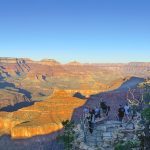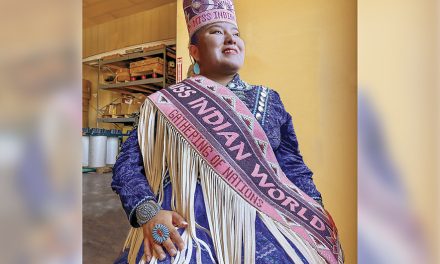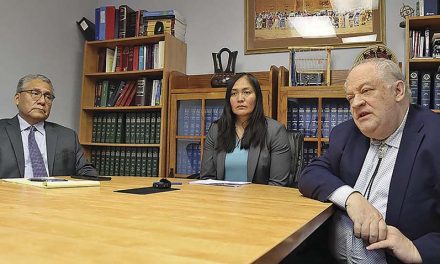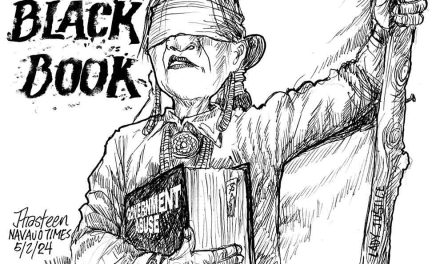
RDC discusses sheep units on NPL, impacts of drought
GALLUP
In a Resources and Development Committee work session on Monday, the possibility of increasing the limit of 10 sheep within the Navajo Partitioned Lands was discussed.
This limit was initially put in place to prevent overgrazing and to protect the vegetation in the area.
The issue brought up many concerns and backlash from people who reside in the area.
Robert Allan, an attorney with the Division of Natural Resources, said according to policy it is possible to change the stocking rate from 10 sheep units.
Federal regulations state that all grazing permits issued in the NPL have restrictions. These restrictions include grazing permits should not be issued for less than two animal units, or 10 sheep units, or exceed 70 animal units, or 350 sheep units.
Regarding grazing capacities and stocking rates, federal regulations state that the Bureau of Indian Affairs with the concurrence of the Navajo Nation, which includes the RDC resolution approving the stocking rates, can adjust the carrying capacity of each range unit by determining the number of livestock or wildlife that can be grazed without damaging vegetation or related sources.
Hear the concerns of the people
Delegate Kee Allen Begay Jr. started the discussion by saying he will continue to push for the 50 sheep unit legislation.
He understands the BIA is only following the policy that is in place at the D.C. level.
“To some extent, I know that they probably don’t even have an understanding about the Navajo Nation and even the culture and traditions of our Navajo people,” Begay said. “I mean that’s the bottom line.”
He believes Council and other entities holding this policy in place need to hear the concerns of the Navajo people “rather than pushing a lot of these policies which are done by non-Navajos.”
During the meeting, the concerns of some residents who live in the NPL were heard. The ones who did speak begged for the sheep unit number to be raised.
“One of the things we need to keep in mind,” Carolyn Johnson said, “this (10-sheep unit limit) impacts our communities, this impacts our spiritual way of life, and our economy, what little that’s out there.”
She said as farmers, they know what is best for their livestock and wildlife because they are out there with them.
Calvert Curley, supervisory natural resource specialist at the BIA, said they are not there only to say no to 50 sheep units.
“We’re saying that, you know, let’s take a look at the land and let’s take a look at it from there,” Curley said. “And over time, yes, there’s that possibility that it’s going to increase.
“We never said that it’s never going to increase,” he said. “We’ve always said that if you properly manage your land, yes, that’s when we can increase to 50 sheep units.”
The BIA is in a “unique position,” he said, because they have a trust responsibility to make sure the Navajo Nation is protected along with Diné land, resources and vegetation.
“If there’s no resources, that’s where the legal issues come in and it’s going to be pointed at us to say that BIA allowed for this many livestock out there permitted so that’s something that we go through,” Curley said.
If there is a possibility of increasing the number of sheep units, he said there is steps that they need to follow.
“The first step is determining what the carrying capacity and stock rate is, that’s step one,” Curley said.
The current drought the Navajo Nation is experiencing has been happening for more than 10 years and is contributing to the issue of vegetation loss.
Severe drought
Gloria Tom, director of the Fish and Wildlife Department, explained how her department is working to confront the drought.
In July 2021, RDC went on a drought tour of the Nation where all areas were examined and a severe situation was discovered.
“During that weeklong tour, we heard from various experts from the Navajo Nation, from the chapters, from the community on the issues that they were facing regarding the lack of water, not only for human consumption, but also for livestock use as well,” Tom said.
She believes that this year will be no different and there is going to be no drought relief for 2022.
Despite this news, the tour resulted in a consultation with RDC which produced recommendations.
Tom said the division’s recommendation of determining the feasibility and developing of hay fields would be considered.
Along with that, other recommendations are downsizing of livestock, deferring livestock grazing for up to a period of five years in some locations, and providing funding to replace outdated water and weather monitoring stations.
Incentive programs that would encourage livestock owners to downsize their herds and implement range management programs, including monitoring range health, were also discussed.
“Another recommendation was to establish regional livestock sales across the Navajo Nation for those livestock owners that don’t have the means to haul their animals to off-reservation markets,” Tom said.
Right now, there are no plans to put these recommendations into place.
Tom said there is a need to approach this situation with the cooperation of the natural resource departments that are involved and the surrounding communities.
“There has to be a need, a want to restore a lot of our lands and that is something we have been trying to do within the Department of Fish and Wildlife under our climate change program,” she said.
She said her department understands the cultural significance of grazing, however, it is contributing to other cultural aspects of Diné culture.
“The department is currently recognizing that grazing is, in addition to a way of life, it’s a very significant activity to our people, culturally and traditionally,” Tom said.
“However, we also have other impacts to the cultural resources that are occurring because we no longer have the medicinal plants that we used to depend upon,” she said, “because of the drought situation and the overgrazing that we’re seeing in most areas of the Navajo Nation.”








 Highway 264,
Highway 264, I-40, WB @ Winslow
I-40, WB @ Winslow